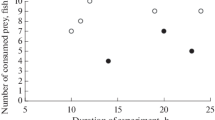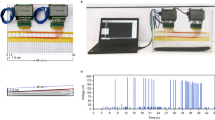Summary
-
1.
The prey capture behaviour and the pattern of the associated electric organ discharge (EOD) were studied in the electric eel, Electrophorus electricus.
-
2.
The resting fish emits only low-voltage EODs at a rate of about 1 Hz; the rate of this emission increases during swimming, reaching values of 10 Hz.
-
3.
The strong electric discharge is emitted during prey capture as well as while hunting prey. Prey capture discharge trains comprise between 50 and several thousand impulses. In the case of prey capture failure, the number of impulses is significantly lower (Fig. 3). A hunting discharge is composed of high-voltage pulses at 500 Hz, the first one being preceded by a single low-voltage pulse.
-
4.
Prey capture discharge trains occur any time during an ongoing low-voltage pulse train. The first pulse of the train is generally of low amplitude, preceding by 2 ms the strong electric pulses. Depending on the time relationship to the low-voltage EOD, this first impulse may show variable amplitude (Fig. 5).
-
5.
In all the fish studied, the frequency of the Sach's electric organ discharge increased before the onset of the strong pulse train. However, this increase was only significant for the last pulse (Fig. 4). No evidence was found that the prey was detected by the low-voltage EOD.
-
6.
The prey capture discharge may be easily elicited by water displacement directed towards the head of the electric eel.
Similar content being viewed by others
References
Albe-Fessard, D., Chagas, C.: Etude de la sommation à la jonction nerf-électroplaque chez le gymnote (Electrophorus electricus). J. Physiol. (Paris) 36, 823–840 (1954)
Bauer, R.: Untersuchungen zur Entladungstätigkeit und zum Beutefangverhalten des Zitterwelses Malapterurus electricus Camelin 1789 (Siluroidae-Malapteruridae, Lacep 1803). Z. vergl. Physiol. 59, 371–402 (1968)
Bauer, R.: La décharge électrique pendant le comportement alimentaire d'Electrophorus electricus. J. Physiol. (Paris) 62 [Suppl. 3], 341–342 (1970)
Eelbenoit, P.: Comportement alimentaire et décharge électrique associée chez Torpedo marmorata (Selachii, Pisces). Z. vergl. Physiol. 67, 205–216 (1970)
Belbenoit, P., Bauer, R.: Comportement alimentaire et décharge électrique de Torpedo marmorata (Chondrychtyes). J. Physiol. (Paris) 65, 347 (1972)
Bennett, M.V.L., Gimenez, M., Nakajima, Y., Pappas, G.D.: Physiology and ultrastructure of electronic junctions. III. Giant electromotor neurones of Malapterurus electricus. J. Neurophysiol. 30, 236–300 (1967)
Coates, C.W., Cox, R.T., Rosenblith, W.A., Brown, M.V.: Propagation of the electric impulse along the organs of the electric eel Electrophorus electricus. Zoologica (NY) 25, 249–256 (1940)
Couceiro, A., Fessard, A.: Quelques données histologiques sur le noyau de commande centrale de la décharge électrique chez l'Electrophorus electricus. Neurobiologia 16, 299–305 (1953)
Fessard, A. Les organes électriques. In: Traité de zoologie, Vol. 13. Grassé, P.P. (ed.), pp. 1143–1238. Paris: Masson 1958
Hagiwara, S., Szabo, T., Enger, P.S.: Physiological properties of electroreceptors in the electric eel, Electrophorus electricus. J. Neurophysiol. 28, 775–783 (1965)
Keynes, R.D.: The feeding habits of the electric eel (Film). Proc. Physiol. Soc. 27.28.4 (1962)
Kreutzer, C.: Unveröffentlicht. Zit. nach P. Meyer-Waarden and I.v.E. Halsband. Einführung in die Elektrofischerei. Berlin: Westliche Verlagsgesell schaft Heenemann KG 1965
Szabo, T.: Anatomo-physiologie des centres nerveux spécifiques de quelques organes électriques. Bioelectrogenesis. Proc. Symp. Comp. Bioelectrogenesis, Rio de Janeiro, 185–210 (1961)
Author information
Authors and Affiliations
Additional information
This report was prepared by T. Szabo on the basis of a manuscript left by our late colleague Richard Bauer
Reprint requests should be addressed to: Dr. T. Szabo, C.N.R.S. LPN 3, F-91190 Gif-surYvette, France
Rights and permissions
About this article
Cite this article
Bauer, R. Electric organ discharge (EOD) and prey capture behaviour in the electric eel, Electrophorus electricus . Behav Ecol Sociobiol 4, 311–319 (1979). https://doi.org/10.1007/BF00303239
Received:
Issue Date:
DOI: https://doi.org/10.1007/BF00303239




